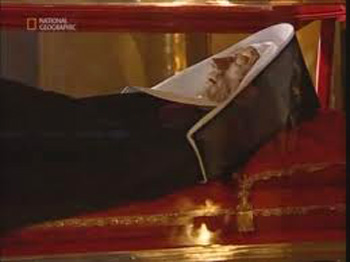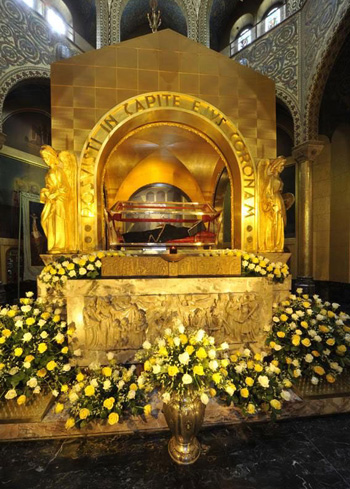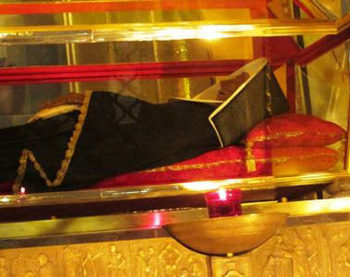Stories & Legends
 |
 |
 |
 |
 |
 |
 |
Marvels at St. Rita’s Sepulchre
It was the Almighty’s will that the body of the St. Rita, born of a mother so long barren, visited by the wonderful bees, miraculously brought into the convent, marked by a wound from a thorn of the Crucified One, and in death crowned with splendor and clothed with an almost heavenly beauty, should also be glorified in a singular manner after death.
 And so has her body remained for several centuries without showing the least sign of decay, and may be seen even to the present day miraculously preserved. Before the year 1628 – that is, for a space of 171 years – her eyes were always seen to be closed, and so they appear in pictures before and after that date.
And so has her body remained for several centuries without showing the least sign of decay, and may be seen even to the present day miraculously preserved. Before the year 1628 – that is, for a space of 171 years – her eyes were always seen to be closed, and so they appear in pictures before and after that date.
But in that year a tumultuous brawl over some insignificant matter arose in the church on a day on which ceremonies more solemn than usual were being observed to celebrate the granting of an Office in the Saint’s honor. On that occasion the eyes of the Saint were seen to open, to the great amazement of all present.
The scandalous conduct of those who had caused the tumult, and through passion violated the laws of charity and the sanctity of the holy place, seems to have awakened that venerable body from its long repose. For it raised itself aloft out of its resting-place, while a perfume as from Paradise filled the church. The Saint’s eyes opened and thus struck terror into the hearts of the brawlers, and filled them with penitence for their deeds, so that the Sacred Offices were finished in peace.
The scene we have described calls us to consider a second prodigy, that of the fragrance which is often observed in the vicinity of the Saint’s body – an odor of unsurpassed sweetness, which invites to devotion and brings spiritual comfort and consolation.
It lasts sometimes for a considerable period; sometimes it is very transient. It diffuses itself to a great distance at times, or is only apparent in the vicinity of the body, and at different times has different degrees of pleasantness.
This, which we might call an odor of Paradise, is sometimes so widely diffused as to be noticeable not only in the church where the body is preserved and in the adjacent convent, but also in the neighboring houses and in the streets. It is wonderful that it has never seemed unpleasant to anyone, but, on the contrary, has brought spiritual consolation and excited the devotion of those who have had the happiness of experiencing it.
There are many documents in existence which give the fullest testimony regarding this wonderful fragrance, and notably the processes of St. Rita’s canonization, which put beyond all doubt the fact that it is really supernatural. For neither was Rita’s body ever embalmed, as we have said, nor were any spices or other odoriferous substances ever placed either within or near the receptacle wherein it lies.
Moreover, it is an ancient tradition in Cascia, which is confirmed also by the writers of her life and by the processes of beatification and canonization, that on the occasions of the triduums that are accustomed to be offered at the altar of the Saint for the sick who have recourse to her, it is not hard to discover whether they are going to get back health or are going to die. For a sweeter perfume is given forth when the object of prayer is to be granted, whereas an odor somewhat like that of incense, or the absence of odor altogether, is an indication of death.
 Stranger still, the same wonderful fragrance has been experienced even in distant countries when extraordinary graces have been obtained by the intercession and through the invocation of St. Rita. So the constant tradition affirms, and the processes of canonization confirm tradition in this point.
Stranger still, the same wonderful fragrance has been experienced even in distant countries when extraordinary graces have been obtained by the intercession and through the invocation of St. Rita. So the constant tradition affirms, and the processes of canonization confirm tradition in this point.
Fr. Rabbi quotes a specific case in proof of this belief. A medical doctor, Signor Andrea, came from Sinigaglia to Cascia with his wife Violante to thank the Saint for her intercession and to present a silver votive offering for the healing of their son, who had been cured of a mortal illness. The healing of their son had been signified to them a little before they came to Cascia by the same wonderful fragrance.
These sweet odors are also manifest [or used to be in the past before Vatican II] whenever the Bishop of Spoleto or the Augustinian Provincial came to hold their usual visitations, not to mention many other occasions.
Another fact calculated to cause still greater surprise is that St. Rita’s body has been seen to raise itself in its coffin from the bottom of that receptacle up to the grating on its top, especially during the time of the Provincial’s visitation.
The same wonderful occurrence has also been remarked during the visitations of the Bishops of Spoleto in the Augustinian convent, as if the Saint thereby wished to renew her homage to her episcopal Superior.
On these occasions the motion of the body is not always the same. Sometimes it has been remarked to be much slower than at other times, and it has on occasions been seen to raise itself for a moment and then sink back again into its usual place. On many other occasions besides at times of visitation, this spontaneous raising of the body has been noticed.
This beautiful fragrance experienced near St. Rita’s body is the first miracle approved for her canonization. In the next article we will see the second miracle she worked for one who called on her assistance.
To be continued



The incorrupt body of St. Rita, below, depicted with the wound on her forehead from the crown of thorns,

But in that year a tumultuous brawl over some insignificant matter arose in the church on a day on which ceremonies more solemn than usual were being observed to celebrate the granting of an Office in the Saint’s honor. On that occasion the eyes of the Saint were seen to open, to the great amazement of all present.
The scandalous conduct of those who had caused the tumult, and through passion violated the laws of charity and the sanctity of the holy place, seems to have awakened that venerable body from its long repose. For it raised itself aloft out of its resting-place, while a perfume as from Paradise filled the church. The Saint’s eyes opened and thus struck terror into the hearts of the brawlers, and filled them with penitence for their deeds, so that the Sacred Offices were finished in peace.
The scene we have described calls us to consider a second prodigy, that of the fragrance which is often observed in the vicinity of the Saint’s body – an odor of unsurpassed sweetness, which invites to devotion and brings spiritual comfort and consolation.
It lasts sometimes for a considerable period; sometimes it is very transient. It diffuses itself to a great distance at times, or is only apparent in the vicinity of the body, and at different times has different degrees of pleasantness.
This, which we might call an odor of Paradise, is sometimes so widely diffused as to be noticeable not only in the church where the body is preserved and in the adjacent convent, but also in the neighboring houses and in the streets. It is wonderful that it has never seemed unpleasant to anyone, but, on the contrary, has brought spiritual consolation and excited the devotion of those who have had the happiness of experiencing it.
There are many documents in existence which give the fullest testimony regarding this wonderful fragrance, and notably the processes of St. Rita’s canonization, which put beyond all doubt the fact that it is really supernatural. For neither was Rita’s body ever embalmed, as we have said, nor were any spices or other odoriferous substances ever placed either within or near the receptacle wherein it lies.
Moreover, it is an ancient tradition in Cascia, which is confirmed also by the writers of her life and by the processes of beatification and canonization, that on the occasions of the triduums that are accustomed to be offered at the altar of the Saint for the sick who have recourse to her, it is not hard to discover whether they are going to get back health or are going to die. For a sweeter perfume is given forth when the object of prayer is to be granted, whereas an odor somewhat like that of incense, or the absence of odor altogether, is an indication of death.

The sepulchre of St. Rita in the Basilica in Cascia, often filled with a sweet fragrance; today her body is less preserved than in the past & the marvels at her sepulchre less frequent

Fr. Rabbi quotes a specific case in proof of this belief. A medical doctor, Signor Andrea, came from Sinigaglia to Cascia with his wife Violante to thank the Saint for her intercession and to present a silver votive offering for the healing of their son, who had been cured of a mortal illness. The healing of their son had been signified to them a little before they came to Cascia by the same wonderful fragrance.
These sweet odors are also manifest [or used to be in the past before Vatican II] whenever the Bishop of Spoleto or the Augustinian Provincial came to hold their usual visitations, not to mention many other occasions.
Another fact calculated to cause still greater surprise is that St. Rita’s body has been seen to raise itself in its coffin from the bottom of that receptacle up to the grating on its top, especially during the time of the Provincial’s visitation.
The same wonderful occurrence has also been remarked during the visitations of the Bishops of Spoleto in the Augustinian convent, as if the Saint thereby wished to renew her homage to her episcopal Superior.
On these occasions the motion of the body is not always the same. Sometimes it has been remarked to be much slower than at other times, and it has on occasions been seen to raise itself for a moment and then sink back again into its usual place. On many other occasions besides at times of visitation, this spontaneous raising of the body has been noticed.
This beautiful fragrance experienced near St. Rita’s body is the first miracle approved for her canonization. In the next article we will see the second miracle she worked for one who called on her assistance.
To be continued
Excerpt from Fr. Richard Connolly, OSA:
Life of St. Rita of Cascia,, London, 1903, Part III,
Posted May 24, 2025
Life of St. Rita of Cascia,, London, 1903, Part III,
Posted May 24, 2025







